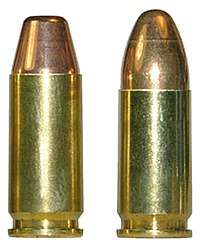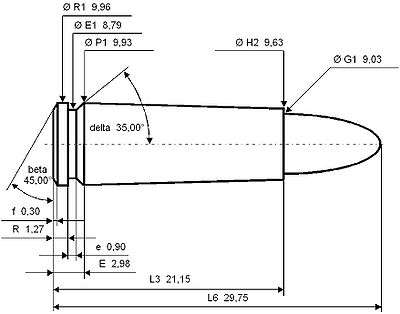9×21mm
The 9×21mm pistol cartridge (also known as the 9×21mm IMI or 9 mm IMI or 9x21mm Italian or 9mm Italian) was designed by Jager (Loano, Italy), then adopted and commercialised by Israel Military Industries for those markets where military service cartridges, like the 9×19mm Parabellum, are banned by law for civilian use (such as in Italy).
| 9×21mm | ||||||||||||
|---|---|---|---|---|---|---|---|---|---|---|---|---|
 9×21mm (left) and parent 9×19mm Parabellum (right) cartridges | ||||||||||||
| Type | Pistol | |||||||||||
| Place of origin | Israel | |||||||||||
| Production history | ||||||||||||
| Designer | Israel Military Industries | |||||||||||
| Specifications | ||||||||||||
| Parent case | 9×19mm Parabellum | |||||||||||
| Case type | Rimless, straight | |||||||||||
| Bullet diameter | 9.03 mm (0.356 in) | |||||||||||
| Neck diameter | 9.63 mm (0.379 in) | |||||||||||
| Base diameter | 9.93 mm (0.391 in) | |||||||||||
| Rim diameter | 9.96 mm (0.392 in) | |||||||||||
| Rim thickness | 1.27 mm (0.050 in) | |||||||||||
| Case length | 21.15 mm (0.833 in) | |||||||||||
| Overall length | 29.75 mm (1.171 in) | |||||||||||
| Case capacity | 1.01 cm3 (15.6 gr H2O) | |||||||||||
| Rifling twist | 254 mm (1 in 10 in) | |||||||||||
| Primer type | Small pistol | |||||||||||
| Maximum pressure | 235.00 MPa (34,084 psi) | |||||||||||
| Ballistic performance | ||||||||||||
| ||||||||||||
| Source(s): C.I.P.[1] | ||||||||||||
History
Based on the 9×19mm Parabellum cartridge, the case was lengthened from 19.05 to 21.15 mm (0.750 to 0.833 in). The bullet sits slightly deeper in the case, which results in almost the same overall length as the 9×19mm Parabellum cartridge (29.69 to 29.75 mm (1.169 to 1.171 in)).
The cartridge was designed by Mr. Giordano & Mr. Piscetta to be used for civil purposes with large pistols (also those designed for .45 ACP). It was named 9 mm GP. The users were not enthusiastic at the very beginning for several reasons, such as the fact that barrels had to be modified.
During the '80's, the cartridge became the perfect caliber to be used for all those automatic pistols designed for military cartridges (i.e.9x19mm) all over the world that are frequently forbidden for civilian uses; for this reason Israel Military Industries (IMI) started to use 9x21mm. During that period IMI got permission to import the UZI Defender (also called Micro Uzi) into Italy chambered for 9x21 IMI. It was the first official commercial launch for the 9x21mm. From that period on several companies in Italy started to sell 9x21mm pistols and ammunition. In just a few decades, the 9x21mm GP or 9x21 IMI became roughly 80% of the civilian small arms market in Italy.
Notes
As it is a rimless round, the 9×21mm is used in USPSA/IPSC competition in Open class firearms. A rimless case is preferred because, unlike rimmed cartridges, it will not tend to lock together with other rounds in a double-column magazine, resulting in a malfunction. As other .38 Super–based rimless cartridges became available, the 9×21mm decreased in popularity in the United States for competition use, but it is still widely used in the rest of the world.
Synonyms
- 9×21mm IMI
- 9 mm IMI
- 9mm Italiano
- Winchester 9×21mm WIN [124-gr. Bullet]
Cartridge dimensions
The 9×21mm has 1.01 ml (15.5 grains H2O) cartridge case capacity.

9×21mm maximum C.I.P. cartridge dimensions.[1] All sizes in millimeters (mm).
The common rifling twist rate for this cartridge is 254 mm (1 in 10 in), 4 grooves, Ø lands = 8.79 mm, Ø grooves = 9.03 mm, land width = 3.80 mm and the primer type is small pistol.
According to the official C.I.P. (Commission Internationale Permanente pour l'épreuve des armes à feu portatives) guidelines, the 9×21mm case can handle up to 235 MPa (34,100 psi) piezo pressure. In C.I.P. regulated countries every pistol cartridge combo has to be proofed at 130% of this maximum C.I.P. pressure to certify for sale to consumers.
References
- "C.I.P. decisions, texts and tables - free current C.I.P. CD-ROM version download (ZIP and RAR format)". Archived from the original on June 6, 2009. Retrieved 2008-10-17.
Further reading
- "Cartuccia 9x21 GP - 9x21 Jager - 9x21 IMI". italianshooters.org (in Italian).